How to bend a profile pipe with your own hands without special tools
Profile pipes are indispensable in the assembly process of frames for building structures. Greenhouses, a variety of greenhouses, gazebos and other facilities are being built with their help quite quickly and efficiently. However, everything is not so simple.
To bend such a pipe, one has to use expensive special equipment, which is not always acceptable for a home foreman. Let's talk about how to bend a profile pipe at home.
The content of the article:
Profile pipe - what is it?
A profile is considered to be a pipe having a different cross-section. It can be rectangular, oval, hexagonal or square. The pipe has increased strength, because its faces take on the role of stiffeners.
Profile products cope with significant bending loads, which makes them a good choice for the construction of a metal frame for buildings of various purposes.
The raw materials for the production of shaped pipes are often high or low alloy steel. Depending on the manufacturing method, there are distinguished electric-welded, cold and hot-rolled, seamless pipes.
Products differ in wall thickness and profile height. Such pipes can be used for the manufacture of various parts in the form of frames, stairs and railings. Most often, a profile pipe is used in construction for the construction of arched structures and as a replacement for iron bars in the construction of frames.
Skills in bending a profile pipe will be useful to home craftsmen who want to independently equip a suburban area:
Possible complications during work
The actual bending of such a pipe is a process of giving the element a curved-smooth configuration. This can only be done under pressure, because the part has high strength. To reduce the pressure required for bending, heating of the bending fragment can be used.
Despite the apparent simplicity of the operation, as a result of bending, elements of the desired configuration are not always obtained. Quite often there are problems. Among the most common complications include three.
The first is that the inner side of the profile is formed by peculiar folds that resemble a corrugation. In the correct version, it is evenly reduced.
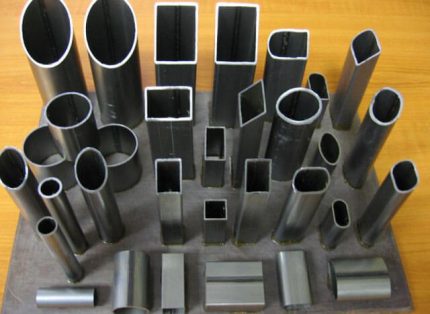
The second difficulty is the rupture of the outer wall of the profile pipe. During bending, it stretches. Sometimes the metal does not withstand force and bursts. The third problem is that the pipe, changing its shape, can lose the alignment of the elements.
This means that its fragments in a bent state will lie in different planes. And this is unacceptable. Practice shows that all difficulties occur due to the erroneous choice of the method of bending.
To choose it correctly, you need to take into account the plastic capabilities of the profile pipe. They are determined by the size and shape of the cross section, as well as the thickness of the walls of the product. Based on these values, it is possible to calculate the minimum possible radius of curvature. Trying to round a smaller radius is strongly discouraged.
To determine the minimum radius, we need a section height. It is calculated as follows. The profile height is measured, doubled wall thickness of the product is subtracted from it.
The resulting number will be the desired height, we denote it by h. For pipes with a rectangular and square cross-section, the following rule applies. If the height of the profile is higher than 20 mm, the part withstands bending in the section, the minimum length of which is hx3.5.
Products with a profile below 20 mm can be bent on a section of a length of hx2.5 or more. This rule applies to all pipes. However, the wall thickness of the part also affects limitations in bending.
The thinner it is, the higher the likelihood of a break or crushing of the part. Experts strongly do not recommend trying to bend wide products whose wall thickness is less than 2 mm. In this case, it is optimal to use a welding machine.
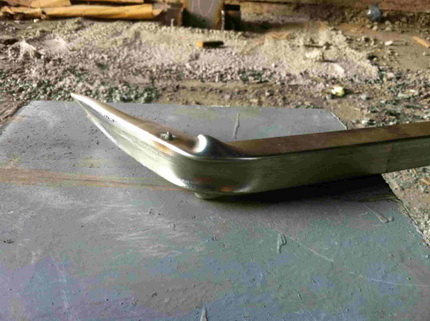
Another point to be aware of.Pipes made of low alloy and carbon alloys are very elastic and, after bending, can somehow “spring”, trying to take their previous shape.
This implies additional work with the product, since it will have to be customized again according to a prefabricated template. Therefore, it is recommended to find out the value of the plastic moment of resistance of a given profile pipe and carry out bending taking into account this indicator. The smaller it is, the less the part will “spring”.
Features of different ways of profile bending
There are two main methods for bending a profile pipe: cold and hot. The first assumes that the bending process is performed without a preliminary temperature effect on the part.
Whereas the second is carried out only with a preheated pipe. Admittedly, heating a part significantly increases its ductility and facilitates the bending process.
There are no standards strictly regulating the use of the cold and hot bending method for profile products. They are only for pipes with a circular cross section. According to these standards, hot bending is used for parts with a diameter of 100 mm or more. For rectangular and square pipes, slightly different rules apply.
If there is a one-time work on pipe bending, you can buy it, but it is better to rent a hydraulic pipe bender with a manual drive:
Plumbers recommend bending all pipes with a profile height of less than 10 mm only in a cold way. Products with a profile height of 40 mm and above are bent by the hot method.
How to bend parts with a profile height of 10 to 40 mm is up to the performer to decide. In order not to make a mistake, you can make a trial bending. In general, if available pipe bender, with its help you can bend the pipe without any heating.
If there is no special tool, it is worth performing a trial bending of the profile pipe. To do this, one edge of the part is firmly clamped in a vice. A pipe of a larger diameter than that of the bent product is put on the other end.
The resulting "shoulder" should be strongly pulled, bending the product. If the part bends, the cold bending method can be used. If not, bending with preheating is applied.
The subtleties of hot bending
Bending of a fragment of a profile pipe occurs after it is heated. It is advisable to perform the operation in one approach, since repeated heating of the metal is undesirable. A product cooled to a light cherry color may burst.
Therefore, this method is ideal for performing angular unit bending. To bend the profile under a rounded arch, it must be used with caution, since repeated heating in this case is inevitable.
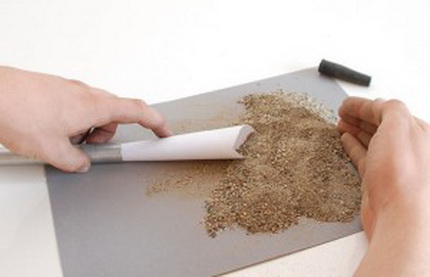
To properly bend the profile pipe in a hot way, a filler should be used. This will prevent possible crushing of the part. As a filler sand is usually taken.
The best option is medium-grained construction sand. If not, material from a children's sandbox is suitable. First you need to clean it from unnecessary impurities.
To do this, the sand is sieved through a sieve with cells of 2-2.5 mm in size. So you can get rid of large pebbles and debris. If during the bending process such an inclusion is directly at the pipe wall, it will form a relief that is completely unnecessary.
Too small grains of sand are also not needed. In the process of heating, they are able to sinter, which is undesirable. Therefore, the sand will have to be sieved again, now through a fine sieve. Its mesh size should be about 0.7 mm. Calcined sieved sand.
The filler is ready. Now you can do the detail. First you need to anneal the pipe in the area where the bending will be performed. Then you can begin to manufacture the plugs.
You will need two parts of the same size that will cover both ends of the profile pipe so that the sand in it does not spill out. Stubs are made only of wood, no other material can be used.
Determine the size and shape of the parts. These should be pyramids, each ten times longer than the width of the base. The dimensions of the base itself should almost double the size of the hole that will be closed by this plug. Prepared products must be tried on the pipe.
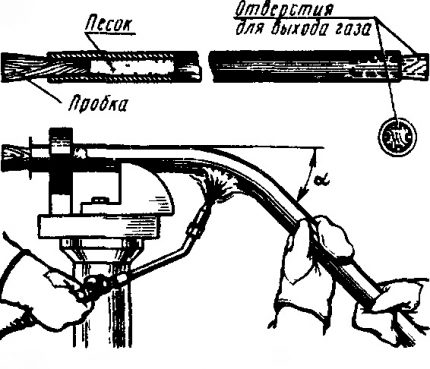
If everything is normal, we perform a longitudinal groove on each side of one of the plugs. Through these grooves, gas accumulated during heating will exit the workpiece. You can start filling the pipe.
To do this, take a plug without grooves and install in place. An ordinary funnel is inserted at the opposite end of the part. If the pipe is long, it is placed at an angle to the ground; if it is short, it is perpendicular.
Sand is poured in small portions through the funnel. After each serving, take a rubber or wooden mallet and thoroughly tap the part from below, helping the sand to distribute as evenly as possible and compact. After a dull sound is heard when tapping the entire length of the pipe, stop work. This means that the part is completely filled with sand.
The blank filled with sand is closed by the second cap. Now you need to draw with chalk the boundaries of the site that will be subjected to heating. Its length must be equal to at least six diameters of the workpiece.
The part is firmly fixed in a clamp or in a vice. If the pipe is welded, it must be fixed so that the seam is outside the bend. If it is inside, the part may burst.
Now you should heat up a fragment of the pipe to a red-cherry color. This can be done with a blowtorch or gas soldering torch. An important point. The entire area should be heated evenly.
Overheating of individual fragments must not be allowed. If this nevertheless happened, such areas should be cooled. An indicator of a sufficiently heated pipe will be a scale that bounces off of it.

After the workpiece is heated, a fragment of a pipe of a larger section is put on its end. So that the edge of the part does not reach the future bend a little. Then the pipe is carefully bent to the desired shape.
You need to do this in one step with a smooth progressive movement in a vertical or horizontal plane. The resulting bend is checked against the template.
The bent pipe should cool, after which it should again be compared with the template and make sure that the shape is correct. If so, the plugs are knocked out. Often it is difficult to do this, then you can just burn out wooden corks and pour out sand.
To make the bend clear, without wrinkles and tears, you need to fill the sand as tightly as possible in the pipe and evenly heat the part.
Features of cold bending
There are several ways to bend a profile without heating. It is easiest to do this using a special tool, namely a roll forming machine. You can buy it or make it yourself, which is quite difficult.
However, buying a tool does not pay off if you just need to bend a few details. Therefore, many are interested in how the bending of the profile pipe is done by hand and whether this is possible at all.
Such an operation is quite possible. For its implementation, the simplest devices in the form of a mandrel or a bending plate will be required. They can easily be assembled from improvised materials. Before bending, you need to determine the filler for the pipe.
If the height of its profile is less than 10 mm, you do not need to fill the part; for products with a higher height, the filler is required. This may be sand prepared in the manner described above, or a spring.
In the latter case, a part made of steel with a tightly wound winding is selected. Its diameter should be such that it fits tightly into the cavity of the profile pipe. Only in this way can it effectively prevent a too sharp change in the cross section of the pipe at the bend site.
So that at the end of work, the spring can be removed without problems, a piece of wire is securely fixed to its edge before installation.
Now you need to determine the type bending tools. This can be done by knowing the height of the product profile. For a thin pipe, with a profile height of less than 10 mm, a bending plate with pins acting as stops is used. They are arranged in accordance with the bending radius of the part. The pipe is laid between the stops, giving it the necessary shape.
They begin to lay the part from the middle, it is easier to perform the operation. Then they gradually move to the edges of the product. A significant disadvantage of this method of bending is the need for significant efforts.
In addition, it is quite difficult to bend exactly according to the pattern, it is very likely that there will be some deviations from the given shape.
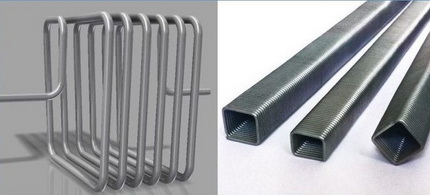
Pipes with a profile height of more than 10, but less than 25 mm, are bent using special equipment equipped with a roller. It operates on the principle of the so-called Volnov machine.
It happens as follows. The part is firmly fixed in a vice. A considerable force is applied to it through the roller, which bends the element. This method allows bending to be performed more accurately and efficiently.
But in this case, you will have to make very significant physical efforts to get the desired result. If you want to get a part with a large bending radius, for example, an arch for a frame structure, plane-parallel plates or a mandrel are used.
The device is a fixed rounded-shaped template on which clamps are used to fix the part.
A profile pipe is effortlessly inserted into a groove whose size exactly matches the profile of the product. Fixing clamps hold the parts of the part in place until the entire element is laid in the fixture. Thus, the pipe is given the desired shape.
If you possess the basic skills of an electric welder, then a simple machine for bending profile pipe rolling can be done with your own hands:
We also recommend that you look at the article in which we talked about how to bend pipes from various metals - read more Further.
The simplest cold bending tools
Consider how to make two very simple fixtures yourself, which will help to bend the profile pipe.
Profile Mandrel
The basis for the adaptation will be a workbench. It is important that not only the work area, but also the space around it be free. To fix the mandrel, you will have to make several closely spaced holes in one edge of the worktop.
The mandrel or template itself is made of plywood. However, this option is acceptable only if several parts are expected to be completed.
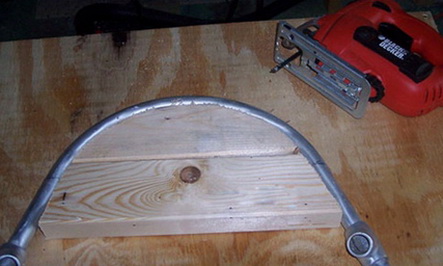
If you need to bend a large number of pipes according to this template, the mandrel is best made from a steel corner. In some cases, the profile product must be bent at different angles.
For such work, you will need several templates at once, which should be prepared in advance. Before starting work, the mandrel is firmly attached to the base with clamps.
The pipe to be bent is reliably fixed to its edge. Then bending is done. The operation is performed smoothly, without sharp jerks. The force applied to the pipe should increase gradually. During bending, the part takes the form of a mandrel. This will require considerable effort.
Advanced bending plate
This is a convenient multifunctional device that allows for high-quality profile bending. The device is a solid metal base plate mounted on a pedestal. The latter, with the help of fixing bolts, is fixed on the workshop floor.
Do-it-yourself simple and affordable bending plate with a mandrel can be made with your own hands:
Alternatively, consider a similar fixture mounted on a workbench. After work, the bending plate is easy to dismantle and remove, or you can use it as a stand for other locksmithing operations.
To make such a device, you need a thick plate of metal. It is welded onto a telescopic stand. For bending stops, two holes are made on the base plate.
They put stop bolts. Nozzles of various radii are put on and fixed on them, which allows you to bend the pipes as needed. A pressure plate is cut out of the thick steel sheet.
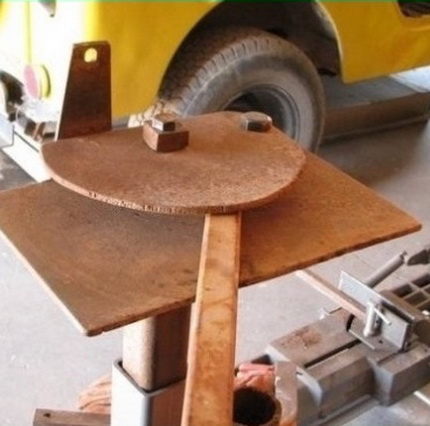
Its use is mandatory so that the alignment of the bent part is not disturbed, since bending a profile pipe without a pipe bender can accidentally deform it in two different directions. The plate is fixed above the nozzles on the stop bolts.
The bending process itself is as follows. A pipe segment is fixed in the fixture, after which it is pulled with effort by the opposite edge. The part should begin to bend. If this does not happen due to insufficient effort, you can try to increase the shoulder by inserting a part with a pipe of a larger diameter.
Conclusions and useful video on the topic
We bend the pipe with a mandrel from steel corners:
How to make a quick and easy homemade pipe bender:
The simplest way to bend a profile pipe:
There are a lot of ways to manually bend profiled pipes. And they all have a common drawback: it takes a lot of effort to bend them. A physically unprepared master may not be able to cope with such work. Bending parts using specialized devices is much simpler, more accurate and does not require special physical effort.
The problem is that the cost of such equipment is quite high. Therefore, buying a device only in order to perform a one-time job is certainly unprofitable. The best option is to rent specialized equipment, which will allow for a small fee to receive profile products, bent exactly according to the pattern.
If you have the necessary skills, please share your experience with our readers. The feedback form is located under the article. There you can ask a question about the topic of the article, and we will try to respond to it promptly.

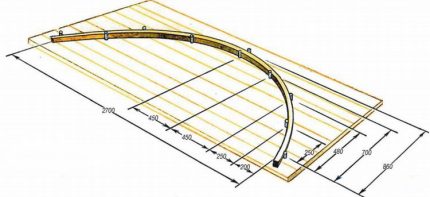
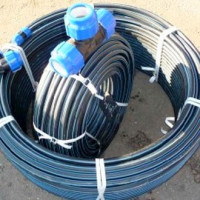 DIY installation of HDPE pipes: welding instructions + how to bend or straighten such pipes
DIY installation of HDPE pipes: welding instructions + how to bend or straighten such pipes 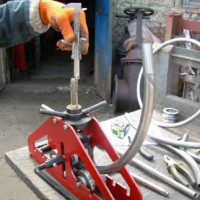 Machine for bending a profile pipe: how to build a pipe bending machine with your own hands
Machine for bending a profile pipe: how to build a pipe bending machine with your own hands 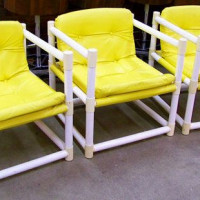 How to make a chair from polypropylene pipes with your own hands: step-by-step instructions for manufacturing
How to make a chair from polypropylene pipes with your own hands: step-by-step instructions for manufacturing 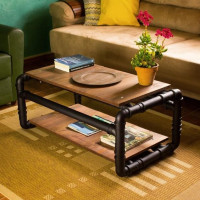 DIY crafts from propylene pipes: do-it-yourself homemade options
DIY crafts from propylene pipes: do-it-yourself homemade options 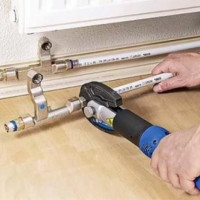 Do-it-yourself installation of plastic pipes: connection technology and wiring examples
Do-it-yourself installation of plastic pipes: connection technology and wiring examples 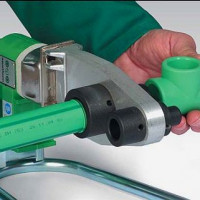 DIY installation of polypropylene pipes: technology for working with PP piping
DIY installation of polypropylene pipes: technology for working with PP piping  How much does it cost to connect gas to a private house: the price of organizing gas supply
How much does it cost to connect gas to a private house: the price of organizing gas supply  The best washing machines with dryer: model rating and customer tips
The best washing machines with dryer: model rating and customer tips  What is the color temperature of light and the nuances of choosing the temperature of the lamps to suit your needs
What is the color temperature of light and the nuances of choosing the temperature of the lamps to suit your needs  Replacement of a geyser in an apartment: replacement paperwork + basic norms and requirements
Replacement of a geyser in an apartment: replacement paperwork + basic norms and requirements
I tried to bend two profile pipes the same way with heating:
1) They turned out different!
2) The inner side went in folds (but it was lucky that the outer one was well and smoothly stretched).
3) I will not take it on my own anymore.
It is strange that no one could tell me in the places of trade where to turn to me for this work. He corrected his mistakes himself, tolerably. Imperfect, but managed.